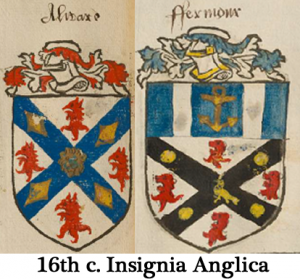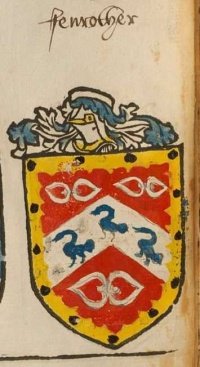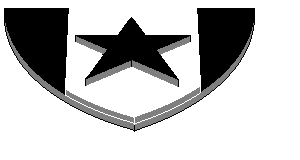Tertiary Charge Group
WARNING: Do not cite this page as a reference. This page is on this wikispace only to make the content "searchable" and easier to find. If you find the information you seek here, go to the original sources as linked below to verify the information and use them for your documentation.
From the Glossary of Terms:[edit | edit source]
Any group of charges placed entirely on other charges. Tertiary charges in a group may be together, such as three charges on a chief, or may each be on members of the same charge group. Per chevron argent and sable, two roses and a fleur-de-lys counterchanged and on a chief purpure three hearts argent has one group of tertiary charges on the chief. Gules, a chevron between three roses Or, each charged with a cross fitchy sable has one group of tertiary charges, the crosses. Or, on a fess gules an escallop between two millrinds Or, all within a bordure vert charged with eight roundels argent// has two groups of tertiary charges, one group with the escallop and millrinds and the other with the roundels. Each tertiary group contributes to difference independently. See also Peripheral Charge Group, Primary Charge Group, Semy. [see also Overall Charge]
http://heraldry.sca.org/coagloss.html
Period Examples:[edit | edit source]

|

|
| Insignia Anglica, English 16th Century | Insignia Anglica, English 1513, shackebolts and geese following the line of the chevron |
A Heraldic Primer: Charges on Charges[edit | edit source]
http://heraldry.sca.org/primer/layers2.html (now defunct)
We have seen how charges on the field are blazoned. It is also possible to have charges that lie completely on other charges, and do not meet the field at all. Such charges form a third layer of the design.
Such charges are blazoned after the charges on which they lie. There are two forms:
- "... on an X, some Y's ..."
- "... some X's (each) charged with some Y's ..."
Form (1) is usually preferred, because it is shorter. But when there are multiple underlying charges, form (2) must be used.
The following picture may help clarify what is meant by charges on charges:
 The illustration shows how "Sable, on a pale argent a mullet sable." might look if viewed obliquely from below to show the different layers. The mullet here is a tertiary charge, since it lays on the pale.
The illustration shows how "Sable, on a pale argent a mullet sable." might look if viewed obliquely from below to show the different layers. The mullet here is a tertiary charge, since it lays on the pale.
Precedents:[edit | edit source]
Precedents of the SCA College of Arms - http://heraldry.sca.org/laurel/precedents.html
Morsulus Heralds Website - http://www.morsulus.org/ (to search the LoARs and Precedents)
Use the above links to be sure any precedents listed below haven't been superseded by newer precedents.
Collected Precedents:[edit | edit source]
- 2nd Tenure of Elisabeth de Rossignol (April 2011 - August 2011) - Collected Armory Precedents
- 1st Tenure of Elisabeth de Rossignol (May 2005 - July 2008) - CHARGE -- Tertiary>
- 2nd Tenure of François la Flamme (October 2004 - May 2005) - Collected Armory Precedents
- The Tenure of Shauna of Carrick Point (May 2004 - August 2004) - Collected Armory Precedents
- 1st Tenure of François la Flamme (August 2001 - April 2004) - Collected Armory Precedents
- The Tenure of Elsbeth Anne Roth (June 1999 - July 2001) - Collected Armory Precedents
- The Tenure of Jaelle of Armida (June 1996 - June 1999) - Single HTML Document
- 2nd Tenure of Da'ud ibn Auda (November 1993 - June 1996) -
- The Tenure of Bruce Draconarius of Mistholme (June 1992 - October 1993) - Collected precedents
- 1st Tenure of Da'ud ibn Auda (June 1990 - June 1992) -
- The Tenure of Alisoun MacCoul of Elphane (September 1986 - June 1990) - Collected Precedents
- The Tenure of Baldwin of Erebor (August 1984 - August 1986) - Single HTML Document
- The Tenure of Wilhelm von Schlüssel (August 1979 - August 1984) - Collected Precedents
- The Tenure of Karina of the Far West (December 1975 - June 1979) - Collected Precedents
- The Early Days (June 1971 - June 1975) - Collected Precedents